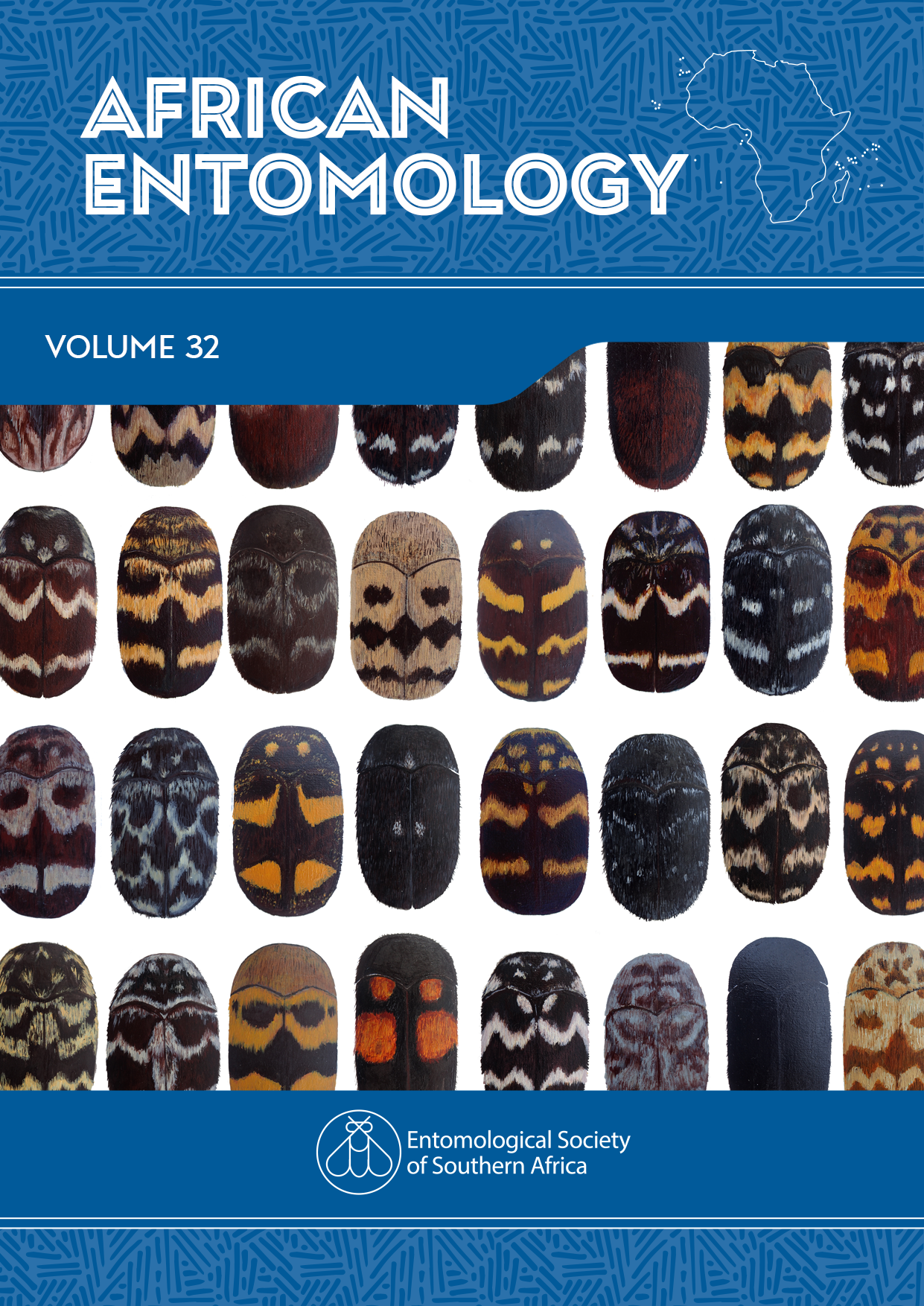Natural enemy release or biotic resistance? Insect herbivores associated with the exotic Solanum viarum (Solanaceae) and a sympatric native congener in KwaZulu-Natal, South Africa
Insect herbivores associated with Solanum viarum and Solanum dasyphyllum
DOI:
https://doi.org/10.17159/2254-8854/2024/a19293Keywords:
Insect herbivore recruitment, invasive Solanaceae, Solanum dasyphyllum, tropical soda apple, weed ecologyAbstract
Native to South America, Solanum viarum Dunal (tropical soda apple; Solanaceae) is naturalised in several countries globally. The plant is a major invader in the southern USA, but has minor weed status in South Africa. We investigated whether S. viarum has escaped natural enemy pressure or has recruited insect herbivores from the local Solanum flora, which are exerting some level of biotic resistance. Insect species richness and abundance and the resulting levels of herbivory were compared between plants from sympatric populations of S. viarum and the native Solanum dasyphyllum Schumacher and Thonning in the KwaZulu-Natal Midlands. Foliage, floral material, and fruits were collected across seasons from 20 plants of each species and assessed in the laboratory. Despite no significant differences between the two species in the size of the sampled plants, S. viarum displayed significantly lower insect herbivore diversity and abundance and suffered significantly lower levels of damage to its photosynthetic and reproductive tissues. Five of the 11 specialist herbivore species recorded on S. dasyphyllum were associated with S. viarum, but in substantially lower numbers and in fewer samples. The flowerbud-galling moth Scrobipalpa sp. (Gelechiidae), which prevents fruiting in S. dasyphyllum, was absent on S. viarum and indicative of the negligible floral damage on S. viarum. Although the fruit of S. viarum were occasionally utilised by specialist herbivores, seed damage was similarly negligible. Due to its release from specialist natural enemies and with no evidence of biotic resistance, S. viarum may increase in weed status in South Africa.
Downloads
References
Arnold TH, De Wet BC. 1993. Plants of Southern Africa: Names and Distribution. Memoirs of the Botanical Survey of South Africa, Vol. 62. National Botanical Institute, Pretoria, South Africa. 825 p.
Blumenthal DM. 2006. Interactions between resource availability and enemy release in plant invasion. Ecology Letters 9(7): 887–895. https://doi.org/10.1111/j.1461-0248.2006.00934.x. DOI: https://doi.org/10.1111/j.1461-0248.2006.00934.x
Coile NC. 1993. Tropical soda apple, Solanum viarum Dunal: The plant from hell (Solanaceae). Florida Division of Plant Industry, Department of Agriculture and Consumer Affairs, Botany Circular 27: 1–4.
DeWalt SJ, Denslow JS, Ickes K. 2004. Natural-enemy release facilitates habitat expansion of the invasive tropical shrub Clidemia hirta. Ecology 85(2): 471–483. https://doi.org/10.1890/02-0728. DOI: https://doi.org/10.1890/02-0728
Diaz R, Manrique V, Hibbard K, Fox A, Roda A, Gandolfo D, McKay F, Medal J, Hight S, Overholt WA. 2014. Successful biological control of tropical soda apple (Solanales: Solanaceae) in Florida: A review of key program components. Florida Entomologist 97(1): 179–190. https://doi.org/10.1653/024.097.0124. DOI: https://doi.org/10.1653/024.097.0124
Gyawali P, Hwang S-Y, Sotelo-Cardona P, Srinivasan R. 2022. Elucidating the fitness of a dead-end trap crop strategy against the tomato fruitworm, Helicoverpa armigera. Insects 2021, 12(6): 506. https://doi.org/10.3390/insects12060506. DOI: https://doi.org/10.3390/insects12060506
Henderson L. 2020. Invasive alien plants in South Africa. Plant Protection Research Institute Handbook No. 21. Agricultural Research Council, South Africa. 384 p.
Hill MP, Hulley PE, Olckers T. 1993. Insect herbivores on the exotic weeds Solanum elaeagnifolium Cavanilles and S. sisymbriifolium Lamarck (Solanaceae) in South Africa. African Entomology 1(2): 175–182.
Hill MP, Hulley PE, Allsopp J, van Harmelen G. 1997. Glandular trichomes on the exotic Solanum sisymbriifolium Lamarck (Solanaceae): Effective deterrents against an indigenous South African herbivore. African Entomology 5(1): 41–50.
Jeschke JM. 2014. General hypotheses in invasion ecology. Diversity and Distributions 20(11): 1229–1234. https://doi.org/10.1111/ddi.12258. DOI: https://doi.org/10.1111/ddi.12258
Keane RM, Crawley MJ. 2002. Exotic plant invasions and the enemy release hypothesis. Trends in Ecology and Evolution 17(4): 164–170. https://doi.org/10.1016/S0169-5347(02)02499-0. DOI: https://doi.org/10.1016/S0169-5347(02)02499-0
Maron JL, Vilà M. 2001. When do herbivores affect plant invasion? Evi-dence for the natural enemies and biotic resistance hypotheses. Oikos 95: 361–373. https://doi.org/10.1034/j.1600-0706.2001.950301.x. DOI: https://doi.org/10.1034/j.1600-0706.2001.950301.x
Mullahey JJ, Nee M, Wunderlin RP, Delaney KR. 1993. Tropical soda apple (Solanum viarum): A new weed threat in subtropical regions. Weed Technology 7(3): 783–786. https://doi.org/10.1017/S0890037X00037714. DOI: https://doi.org/10.1017/S0890037X00037714
Olckers T, Hulley PE. 1989a. Insect herbivore diversity on the exotic weed Solanum mauritianum Scop. and three other Solanum species in the eastern Cape Province. Journal of the Entomological Society of Southern Africa 52(1): 81–93.
Olckers T, Hulley PE. 1989b. Seasonality and biology of common insect herbivores attacking Solanum plants in the eastern Cape Province. Journal of the Entomological Society of Southern Africa 52(1): 109–118.
Olckers T, Hulley PE. 1991. Impoverished insect herbivore faunas on the exotic bugweed Solanum mauritianum Scop. relative to indigenous Solanum species in Natal/KwaZulu and the Transkei. Journal of the Entomological Society of Southern Africa 54(1): 39–50.
Olckers T, Hulley PE. 1995. Importance of preintroduction surveys in the biological control of Solanum weeds in South Africa. Agriculture, Ecosystems & Environment 52(2-3): 179–185. https://doi.org/10.1016/0167-8809(94)00537-O. DOI: https://doi.org/10.1016/0167-8809(94)00537-O
Olckers T, Hulley PE, Hill MP. 1995. Insect herbivores associated with indigenous species of Solanum (Solanaceae) in the Transvaal, South Africa, and in Namibia. African Entomology 3(1): 49–57.
Olckers T, Medal JC, Gandolfo DE. 2002. Insect herbivores associated with species of Solanum (Solanaceae) in northeastern Argentina and southeastern Paraguay, with reference to biological control of weeds in South Africa and the United States of America. Florida Entomologist 85(1): 254–260. https://doi.org/10.1653/0015-4040(2002)085[0254:IHAWSO]2.0.CO;2. DOI: https://doi.org/10.1653/0015-4040(2002)085[0254:IHAWSO]2.0.CO;2
Vorontsova MS, Stern S, Bohs L, Knapp S. 2013. African spiny Solanum (subgenus Leptostemonum, Solanaceae): A thorny phylogenetic tangle. Botanical Journal of the Linnean Society 173(2): 176–193. https://doi.org/10.1111/boj.12053. DOI: https://doi.org/10.1111/boj.12053
Welman WG. 2003. The genus Solanum (Solanaceae) in southern Africa; subgenus Leptostemonum, the introduced sections Acanthophora and Torva. Bothalia 33(1): 1–18. https://doi.org/10.4102/abc.v33i1.429. DOI: https://doi.org/10.4102/abc.v33i1.429
Downloads
Published
Issue
Section
License
Copyright (c) 2024 Terence Olckers, Kwanele Msele, Daniella Egli

This work is licensed under a Creative Commons Attribution 4.0 International License.
How to Cite
Funding data
-
Inyuvesi Yakwazulu-Natali
Grant numbers Honours project allocation




.png)